Right tires can improve Cadillac XT5 and XT6
By John Gilbert
You’ve got to love this time of year, the Christmas break, when you scurry around thinking of a million things, or nothing, you could buy, most of which cost more than you can afford. In the car-testing business, there are numerous possibilities as a late family gift, in every imaginable price range.
We should start at the top. For example, you could buy a luxury SUV, and of you don’t want a gigantic 0one, there are several that might be the perfect gift size, such as the 2022 Cadillac XT5 or XT6. They look a lot alike, but they are two different vehicles. They cruise in the $60,000-$75,000 range, which could dissuade a lot of us.
Before looking those two over, let’s consider something a lot less glamorous, but maybe the best winter insurance available for your family — a set of four “Nokian one” all-season tires. They will astound you at how they make any vehicle run smoothly and quietly in the dry, yet also work well to stick to the road and grab traction in the worst winter storms.
Car-owners in or around Duluth, Minnesota, by the way, should be cautioned to ignore the syndicated story from Detroit that ran a couple of weeks ago in various publications, including the usually reliable Minneapolis Star Tribune, in its weekly automotive page. Now, Detroit doesn’t have hills like Duluth does, so we can cut the guy some slack because maybe he’s never driven to the Upper Peninsula, and never needed true winter tires. But he wrote that the newest winter tires are not all that beneficial, and they are what used to be called “snow tires.”
No. Not true. There are summer tires, there are all-season tires, and there are snow tires, and you get to choose what you want or need. Tire companies make tires for all circumstances, and the newest top all-season tires can handle the duties of winter driving better than more basic summer tires, which run long and smoothly but lack the ability for foul-weather traction, and better than snow tires used to.
But there also are major differences in how different tires work on snow and ice, which is as critical to stopping and cornering as to going forward.
Companies can put whatever designation they want on their tires, it seems, but not many have mastered the technique of making tires that work in snow and on ice in the real world, and also run smoothly when you’re not on snow or ice, which is 90 percent or more of the time, even in severe winters. Plows come out promptly, and a day or two after a storm, you’re back on pavement.
But we’re talking tires for the critical moment when you are cruising along on a winter night, or day, and nearing the apex of a curve when you hit some black ice glazing the pavement, and you start to skid toward the ditch, or abutment. Instantly, your heart is in your throat and your adrenaline goes to overload.
If you know how to hold your poise and steer into the skid with light and careful braking, good for you. But sometimes it’s hopeless because your tires just won’t stick.
In that moment of crisis, how much would you pay to have that situation not exist? Certainly a lot more than $500, because it’s going to cost you a lot more than that to fish your car out of the ditch and to repair the dents you have just installed.
Nokian tires — based in Finland and which used to be “Nokia” but gained an “n” on the end after the Nokia cell phones became worldwide big-sellers — have convinced me from 50 years of test drives in Minnesota winters, and they are the best way to handle the toughest winter conditions.
I first discovered N0kians from a fellow named Dave Erickson, who once ran Bloomington Tire Center in that Twin Cities suburb. He was a racer and knew every detail ab0ut tires, and when he got me to try Nokia tires, it was a revelation. They had the unique ability to go year-round, last a long time, and still alleviate anxious moments on wintry roads.
Nokia designed and built tires for winter rally racing north of the Arctic Circle, and has continued to make tires with a compound that retains its flexibility no matter how cold the weather is. The company’s all-out winter beater is the Hakkapeliitta, which preceded the Bridgestone Blizzak and remains a superb tire today. Blizzaks are excellent on ice and snow, but not as good on normal pavement because their tread decomposes as part of the principle that the remaining tiny concave shapes aid grip, so they wear out faster on dry pavement.
I replaced the super-aggressive-looking Michelin XAS asymmetric-tread tires that came on a beloved Saab 900 we purchased. Impressive as they looked, the XAS tires were excellent in rain, but hopeless in snow and ice, where they slipped and slithered when they should have been gripping and holding course. I went with the Nokia all-season, and found them to be so good I never saw the need to go to the Hakkapeliittas, despite Dave Erickson’s urging.
Dave got out of the tire business a few decades ago, and we moved from the Twin Cities to Duluth since then, where I knew of a place called “Foreign Affairs” that does auto repair and also sells tires. Jeff Hofslund owns Foreign Affairs — great name — and he is similar to Dave Erickson in trying to make sure each customer ends up with the best tire for specific needs. He sold a lot of tires over the years, but mostly prescribes Nokian tires. His always-busy little shop on 7th Av. E. and 8th St. on Duluth’s East Hillside, became the No. 1 U.S. outlet for Nokian sales. He’s not sure if he still holds that honor, but while he can obtain any tire by overnight delivery, he has a separate connection with Nokian, which insists on avoiding large tire shops for what they believe is superior personal satisfaction from smaller companies.
A set of Nokian WG3 tires are serving us well on the family Mini Cooper, and they have directional tread design and a compound that still sticks to the road effectively after five or six years. We bought a new set last year for our older son and they are the new “Nokian one” tires, which don’t look as aggressive as the WG3, but sticks just as well. The new ones are not directional, which makes it easier to rotate them, and are designed to run for significantly more miles, and in amazing silence when running on dry pavement.
As a potential Christmas gift siuggestion, I called Jeff Hofslund and asked how much a new set of Nokian one tires would cost. “It depends,” he said, “on what size, what kind of car, front-wheel, rear-wheel or all-wheel drive, and what type of use would the tires get. I like to try to suggest tires that fit into a family’s lifestyle and vehicle usage.”
Such personal service is right up Nokian’s alley. The new “Nokian one” somehow bridges the compromise between working on icy avenues in Duluth and being just as impressive in year-round driving without the need to switch to summer tires. A new set of four, in 17-inch size for example, would be about $120 apiece, mounted and balanced. That’s nearly $500 for four, which is already a lot, but it’s inexpensive in my concept of eliminating those moments of terror when you lose traction.
It was more than Christmas that caused me to
think of suggesting a set of Nokian tires as a Christmas gift. It was brought to mind by the close-order proximity of test-driving both the high-end Cadillac XT5 SUV and XT6 SUTVs. Both are perfect compromises between sedans or station wagons and midsize SUVs, as far as people-hauling goes. Appropriately, the XT5 is a bit smaller, with two rows of seats, and therefore is priced fr0m a $50,795 base, to a test-vehicle high of $67,965.
The XT6 is just enough longer to fit in foldable third-row seats, which don’t come in the XT5, but the roomier XT6 starts at $54,995 and rises, via the option list, to an as-tested $70,965. If you can afford the $3,000-$5,000 difference, then you can decide. I had the XT5 and XT6 close enough together at the advent of snow and ice season up in the Great White North, offering me the opportunity to compare the all-wheel-drive vehicles.
The XT5 was black, which in Cadillac-ese “Stellar Black Metallic.” It also was lighter and felt a bit sportier — although both vehicles were powered by the same high-end 3.6-liter dual-overhead-cam V6 with 9-speed automatic transmission. The XT5, I must say, slithered around a bit when the roadways got slippery from the snow and ice coating. I got out and checked and noted Michelin Primacy tires, which fit my theory that Michelin takes pride in tires that will endure high speeds and last a lot of miles, two traits not necessarily good for slippery winter conditions.
The XT6, meanwhile, was the “Premium Luxury” version, and was painted “Rosewood Metallic.” It had enlarged 20-inch alloy wheels, on which were mounted Continental all-season Cross-trek tires, with a lot of cross-tread sipes designed to flex just enough to spit out snow and grip slippery road surfaces better. They did that, as we proved when we had more snow in the XT6’s week. It handled it all with no problems.
Both vehicles were loaded with creature features, and the XT5, which is targeting those who might want to do some light off-roading, had an additional mode switch that allowed you to select from tour, AWD, sport, and off-road. Frankly, I can’t see it as an off-road vehicle, but the power is there and the AWD system works.
You can also change modes with the XT6, but not quite as aggressively, as though Cadillac knows the difference between country club and rock-climbing..Both Cadillacs are sized right, above the now-popular compact SUVs but well below the giant SUVs like the Escalade, which is at the top of the Cadillac pecking order.
With all the safety and connectivity features included with both, the price difference basically remains whether you want the pure luxury of the fine leather and wood in the XT6 or the also-nice leather and wood trim in the XT5.
Just make sure, for the price, you take into account what tires you’re buying. They all look good in the showroom, but remember that your total contact with any roadway is less than one square foot at each corner of your car, and making sure your tires share your insistence on staying in contact of those four patches.


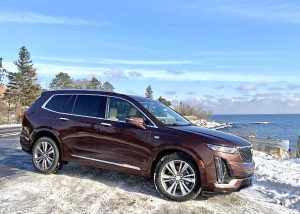
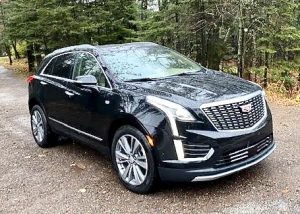
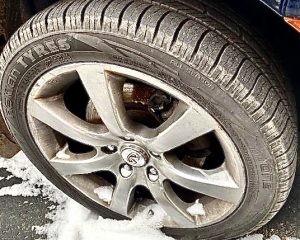
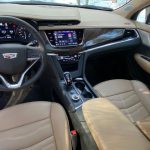
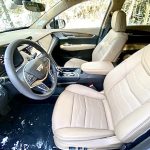
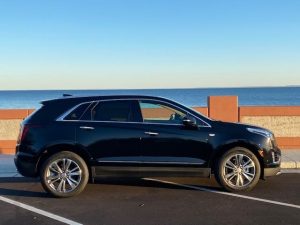
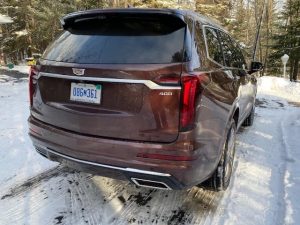
 John Gilbert is a lifetime Minnesotan and career journalist, specializing in cars and sports during and since spending 30 years at the Minneapolis Tribune, now the Star Tribune. More recently, he has continued translating the high-tech world of autos and sharing his passionate insights as a freelance writer/photographer/broadcaster. A member of the prestigious North American Car and Truck of the Year jury since 1993. John can be heard Monday-Friday from 9-11am on 610 KDAL(www.kdal610.com) on the "John Gilbert Show," and writes a column in the Duluth Reader.
John Gilbert is a lifetime Minnesotan and career journalist, specializing in cars and sports during and since spending 30 years at the Minneapolis Tribune, now the Star Tribune. More recently, he has continued translating the high-tech world of autos and sharing his passionate insights as a freelance writer/photographer/broadcaster. A member of the prestigious North American Car and Truck of the Year jury since 1993. John can be heard Monday-Friday from 9-11am on 610 KDAL(www.kdal610.com) on the "John Gilbert Show," and writes a column in the Duluth Reader.